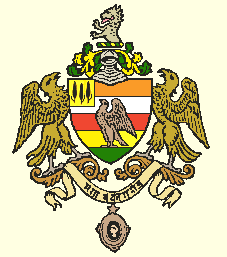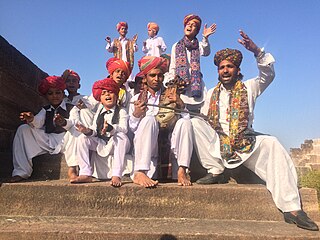Related Research Articles
Chughtai or Chagatai is a family name that originated in the Chagatai Khanate as taken up by the descendants and successors of Chagatai Khan who was the second son of Mongol Emperor Genghis Khan. Accordingly, some of the other descendants of the successors of Chagatai Khan in South and Central Asia use variants such as Mirza, Baig and Khan.

Rao Bika, was a scion of the Rathore clan of Rajputs and the founder of the city of Bikaner and Bikaner State in present-day state of Rajasthan in India. He was the fifth son of Rao Jodha, founder of the city of Jodhpur. During his reign he controlled an area of 40,000 square miles, which included 3,000 villages.
Bhutto is a Sindhi clan found in Sindh, Pakistan. The Bhuttos along with Bhattis and other subclans are said to linked to the Bhati Rajputs. They have been settled in Sindh for over two centuries, having migrated to the area from Jaisalmer in Rajasthan, India under Setho Khan Bhatti in the seventeenth century. According to other authors, the family migrated to Sindh from Sarsa in Hissar. The politically influential Bhutto family of Pakistan hails from this clan.

The Rathore dynasty or Rathor dynasty was an Indian dynasty belonging to the Rathore clan of Rajputs that has historically ruled over parts of Rajasthan, Gujarat and Madhya Pradesh.

Bhati is a Rajput clan that claims descent from a 3rd-century monarch, named Rao Bhati. The Bhati clan historically ruled over several cities in present-day India and Pakistan with their final capital and kingdom being Jaisalmer, India.
The Jaitawats are a subgroup of the Rathore Rajputs of India. They are descendants of Rao Jaita Rathore, who fought historic Battle of Sammel.

Rao Maldeo Rathore was a king of the Rathore dynasty, who ruled the kingdom of Marwar in present day state of Rajasthan. Maldeo ascended the throne in 1531 CE, inheriting a small ancestral principality of Rathore's but after a long period of military actions against his neighbours, Maldeo swept significant territories which included parts of present day Rajasthan, Haryana, Uttar Pradesh, Gujarat and Sindh. He refused to ally with either the Sur Empire or the Mughal Empire.

Rohri is a city of Sukkur District, Sindh province, Pakistan. It is located on the east bank of the Indus River, located directly across from Sukkur, the third largest city in Sindh. Rohri town is the administrative headquarters of Rohri Taluka, and tehsil of Sukkur District with which it forms a metropolitan area. Its capture marked the beginning of Muslim rule in South Asia under Muhammad ibn al-Qasim in 711 CE, when it was named Aror.

Jaisal Singh (1113–1168) was the founder and first ruler of the Kingdom of Jaisalmer, ruling from 1156 to 1168 CE. Singh was a Rajput chief of the Bhati clan who lived during the 12th century. A direct descendant of Rao Bhati, the 3rd-century Hindu monarch and the common ancestor of the Bhati Rajputs, Singh rose to power in 1143 by defeating his nephew, Rawal Bhojdeo of Lodhruva, in battle and seizing his nephew's position as Rawal.
Raja Sálbán was a semi-mythical monarch who, according to historical sources and claims, was active during the 1st and 2nd centuries, and is believed to have founded the city and the fort of Sialkot in Punjab in the 2nd century. According to Punjabi folklore, he was father of Puran Bhagat and Raja Rasalu, the protagonist of the Adventures of Raja Rasalu. Salban's historicity and events in his life are debated by historians, and he is regarded as a semi-legendary figure.

The Manganiar are a Muslim community found in the Thar Desert region of Rajasthan, India; mostly in the districts of Barmer and Jaisalmer, and in the districts of Tharparkar and Sanghar in the bordering province of Sindh in Pakistan.

Rao Bhati was an ancient Hindu monarch (raja) who ruled during c. 3rd century. He is considered the eponymous ancestor of the Bhatti/Bhati clan of Rajputs present in modern-day India and Pakistan. Bhati and his descendants claim direct descent from the Hindu mythological Yaduvanshi lineage of the Lunar dynasty. He is also the common ancestor of many notable individuals and families.
The Gurjar are an agricultural ethnic community, residing mainly in India, Pakistan, and Afghanistan, divided internally into various clan groups. They were traditionally involved in agriculture, pastoral and nomadic activities and formed a large heterogeneous group. The historical role of Gurjars has been quite diverse in society: at one end they have been founders of several kingdoms and dynasties and, at the other end, some are still nomads with no land of their own.

Jangladesh, also known as Janglu, was a historical region in north, north-western and north-eastern Rajasthan state in northern India. It included the present-day districts of Bikaner, Churu, Ganganagar, and Hanumangarh. It was bounded on the south by Marwar and Jaisalmer regions, on the east by Ajmer-Merwara region.

The Phulkian dynasty of Maharajas or sardars were Sikh royals and aristocrats in the Punjab region of India. Members of the dynasty ruled the states of Badrukhan, Bhadaur, Faridkot, Jind, Malaudh, Nabha, and Patiala, allying themselves with the British Empire according to the terms of the Cis-Sutlej treaty of 1809. The dynasty is named after Phul Sidhu-Brar, the 17th-century common ancestor of the Phulkian states and the founder of the Phulkian Misl. Members of the Phulkian dynasty, who are the direct descendants of Rawal Jaisal Singh, the founder and ruler of the Kingdom of Jaisalmer, migrated to the present-day Malwa region in Punjab.

Jaimal Rathore (1507–1568) was the Rathore (Mertiya) ruler of Merta. He was cousin of the Hindu saint Mirabai and Great grandson of Rao Jodha Rathore and Grandson of Rao Duda Rathore. He became the ruler of Merta after the death of his father, Rao Veeram Dev. His father was perceived as the strongest king of the east in his time. The Amar Kavya records that Udai Singh II granted Badnor along with 210 villages to Rao Jaimal. In 1553, Jaimal resisted falling under the chakri of Maldeo of Marwar.

Maharaja Sir Sardar Singh Bahadur was the Maharaja of Jodhpur State from 11 October 1895 till his death on 20 March 1911.
Umade Bhattiyani was the wife of Maldeo Rathore, the renowned Rathore ruler of Marwar. She earned the epithet of Roothi Rani — the Irate or Aggrieved Queen, or 'the Queen-who-Sulked' due to her strained relationship with her husband.
Khyat is a form of bardic historical prose that was prevalent in the western Indian states of Rajasthan and Gujarat. It is a collection of events or continuous history. Khyats generally contained histories of a ruling dynasty or a person. In the former states that now constitute Rajasthan, Khyatas were written by the Charans under the patronage of rulers who wished to perpetuate their exploits. These accounts contained histories of battles, sacrifices, valour, and chivalry, values that came to be associated with Rajputs. Khyatas are often known by the name of their authors; e.g., Bankidās-ri-Khyāt. Nainsi-ri-Khyat written by Nainsi is considered to be the most prominent of khyats.
Ratnu, also spelt as Ratanu or Ratnoo, is a major clan of the Charanas in Rajasthan.
References
- 1 2 Kothiyal, Tanuja (2016). Nomadic Narratives: A History of Mobility and Identity in the Great Indian. Cambridgre University Press. pp. 18, 55–60, 70. ISBN 9781107080317.
the various Hindu Rajput Bhati sub-clans, like Saran, Moodna, Seora as well as Muslim groups like Bhatti, Bhutto...and the trading community of Bhatiya, all link their origins to the Bhatis
- 1 2 Hooja, Rima (2006). A History of Rajasthan. Rupa & Company. p. 551. ISBN 978-81-291-0890-6 . Retrieved 28 October 2024.
- 1 2 Erskine, K. D. (1909). A Gazetteer Of The Jaisalmer State And Some Statistical Tables. Ajmer: Scottish Mission Industries. pp. 11–12.
- 1 2 Kothiyal, Tanuja (2016). Nomadic Narratives: A History of Mobility and Identity in the Great Indian. Cambridgre University Press. p. 73. ISBN 9781107080317.